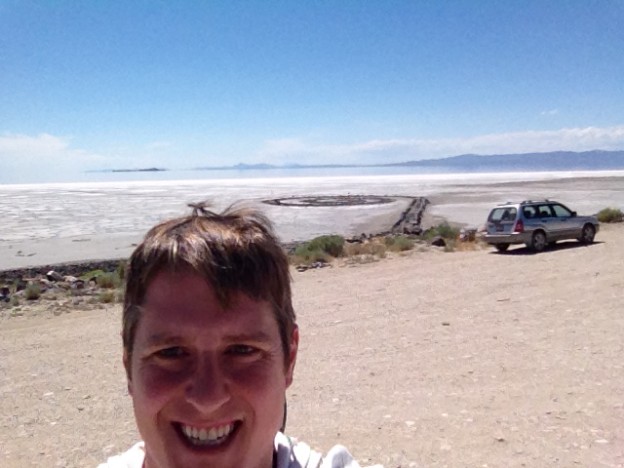I had heard about Spiral Jetty, the land art piece in the Great Salt Lake, probably over a decade ago. On a recent trip to Idaho National Lab, I was scheduled to drive from Salt Lake City to Idaho Falls on a Sunday afternoon.
During my flight out to Salt Lake, two serendipitous moments related to Spiral Jetty occurred. First, I was reading Camille Paglia’s Glittering Images while waiting for a flight. In the section on Walter De Maria’s Lightning Field, a similar outsize art installation in the American West, Paglia mentioned Robert Smithson’s Spiral Jetty as another example of this kind of art. I then looked on my phone to find, a bit to my chagrin, that going to see Spiral Jetty would be about 1.5 – 2 hours out of my way. I didn’t think I really wanted to spend that much time.
Then, on the plane I was reading this article in the Wall Street Journal about travel tastemakers’ travel wish lists. On one of the lists was Spiral Jetty. That sealed it: I was going to make that drive into the desert.
The various websites that give guidance on visiting Spiral Jetty (I’d recommend the Dia website linked above as they are the organization that manages the artwork) say that
- It’s a lot of driving around on dirt/gravel roads,
- There is no cell service at the site (or much of anything else, just a dirt parking lot)
- You go past Promontory Point, the site of the joining of the transcontinental railway
- Check the water level for the Great Salt Lake before going because if the lake level is above 4195 feet, then Spiral Jetty will be submerged.
It’s probably about time I mentioned what Spiral Jetty is. Basically, it’s a spiral made out of rocks that juts out from the shore. Yet, the setting for this sculpture is what gives it a power. As I mentioned you drive into the middle of nowhere, not seeing any cars or buildings for miles. When you get to the shore of the lake there is no sign of civilization other than Spiral Jetty and its small number of visitors. The surrounding landscape is bleak, as in post-apocalyptical bleak. Let’s not forget that it is sited in a giant, dead lake that extends all the way out to the horizon. In this bleakness, emerges this well-ordered, and precise spiral indicating the presence of a great deal of human effort and planning. Seeing the art work in this context is what gives it power.
When I arrived at the work, there were 3 other people there walking on the rocks (something that you are allowed to do). I first took some pictures before descending down to the shore. As I started walking out, the others left and I was alone. Utterly alone. At this point on the edge of the lake, the water melts into the horizon. I marched out to the end of the rock formation along the salt-crusted dry lake bottom, salt crystals crunching under by bare feet. This turned out to be a bad idea because the crystals were large enough to be painful to walk on when I reached the spiral part of the formation. Putting my shoes back on I walked on the rocks over the spiral shape, circling around several times. I took several pictures and then walked back.
The drive back to the main road passed the site of the joining of the eastern and western legs of the first transcontinental railway at Promontory Summit. I stopped in, paid the entrance fee, and saw the actual tracks where it was joined. They have two restored locomotives that they actually drive around. Don’t look for the actual Golden Spike used to join the tracks, it is in a museum at Stanford, which, I suppose, is the prerogative of the owner of the railway.
